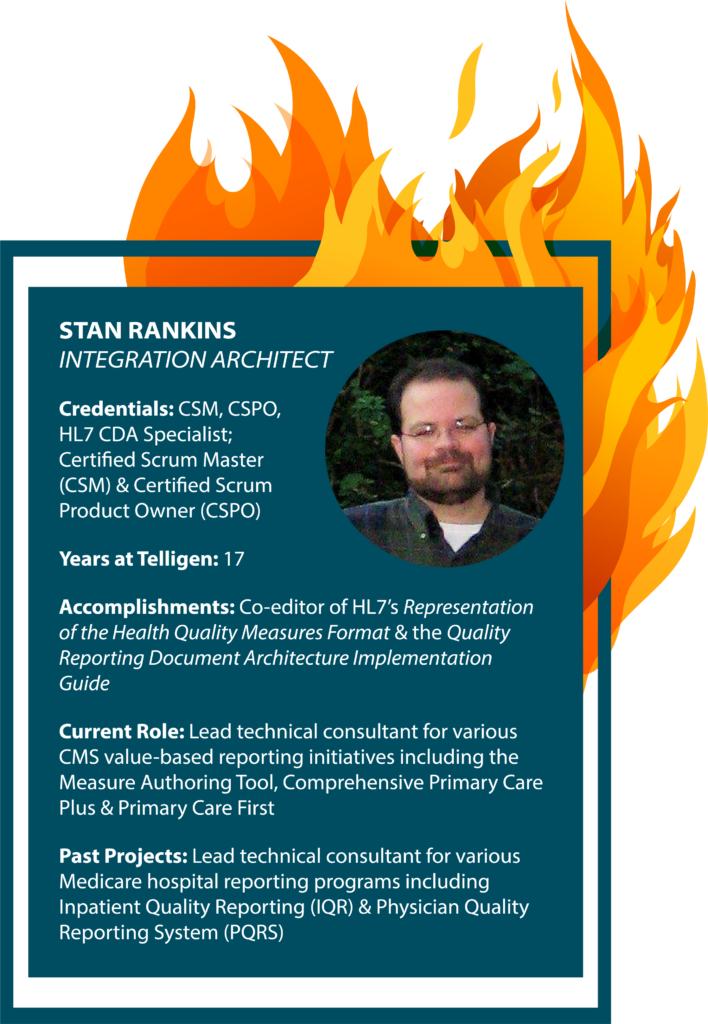Five Rapid FHIR Questions for Stan
Interest in FHIR is growing as it increasingly becomes the go-to standard of Health IT. But what is the Fast Healthcare Interoperability Resource (FHIR), how does it work, and what could it mean for the future of health data interoperability? Stan Rankins, Integration Architect, and Telligen’s resident HL7 expert breaks it down.
DID YOU KNOW?
Stan is running for the 2022 co-chair position of HL7’s Clinical Quality Information (CQI) work group. Voting is open (thru 7/30/2021) to HL7 individual members and organizational representatives who were subscribed to the relevant Listserv by 6/24/2021.
First, describe your role at Telligen. How does your HL7 expertise support Telligen programs?
 [The passage of] Meaningful Use (2009) placed an increased emphasis on health data exchange and HL7 standards. Many of today’s systems communicate with data built on HL7 v2 and v3 formats. [More recently] the 21st Century’s Cures Act (2016), shifted the interoperability focus to FHIR-based Application Programming Interfaces (API).
[The passage of] Meaningful Use (2009) placed an increased emphasis on health data exchange and HL7 standards. Many of today’s systems communicate with data built on HL7 v2 and v3 formats. [More recently] the 21st Century’s Cures Act (2016), shifted the interoperability focus to FHIR-based Application Programming Interfaces (API).
Each year, CMS releases new HL7 electronic Clinical Quality Measures (eCQM) and reporting standards with the goal to consistently improve digital reporting. It’s my job to stay on top of those standards and support Telligen programs and projects that use them.
What are the biggest challenges impacting digital reporting today?
From a technical standpoint, the healthcare industry has not achieved the transformative internet-based experiences that consumers benefit from in other industries such as retail or transportation. What’s missing is a common standard for capturing, transmitting, receiving, storing, and managing patient health data. This causes inaccuracies, delays, increases burden, and prevents us from achieving the full benefits of EHRs and digital reporting.
Why is everyone fired up about FHIR? Will it solve those problems?
A common interoperability standard like HL7 FHIR has the potential to remove current barriers to the flow of information across healthcare sectors and between EHR systems.
FHIR could change all that using web-based technologies that enable APIs. These APIs will allow providers to exchange data through secure a web interface using protocols and technologies similar to those in use by other industries.
What will interoperability look like for patients and providers?
Patients who see multiple providers in different health systems will not have to worry about managing three or four patient portals from facilities using different EHRs. Patients will have access to a single personal health record that compiles data from different formats to deliver a comprehensive picture of all medications, problems, and allergies, etc. This will make patients more informed, empowered, and place them at the center of care.
For providers, the future of the EHR might look a lot like your phone. EHRs, similar to Apple or Android, will provide the platform for accessing APIs customized for the provider’s specialty or area of interest. Eventually, providers will have access to a basic EHR platform with lots of plug-ins added to it.
What is your why? Why devote your career to quality reporting & health IT?
I have family members and friends who have been impacted by medical errors. Some of those medical errors were caused by clinicians not having the right information at the right time. In the time in which we are living, there is no reason why clinicians should not be able to have the most recent and accurate information on their patients.
Healthcare is an industry that everyone counts on and is one of the largest sources of public funding. eCQMs are valuable tools for assessing the quality and outcomes achieved through taxpayer dollars. Modernizing the digital measurement infrastructure will result in more efficient, transparent, and consistent care for everyone.

